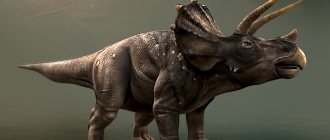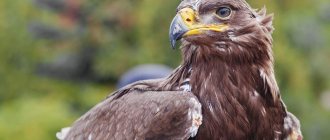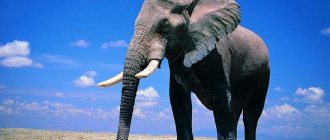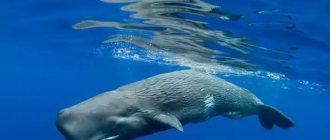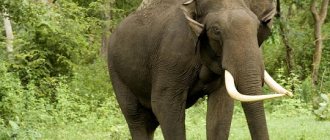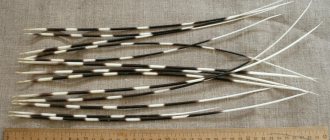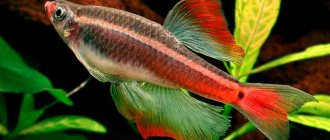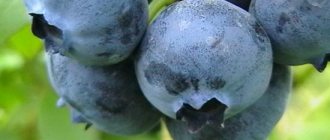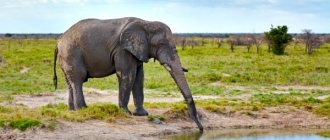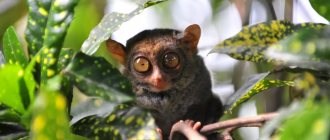The ankylosaur was a large lizard, as tall as a rhinoceros and about as long as a bus. The body of this dinosaur was wide and squat. It walked on four thick legs, and from above it looked flattened and even looked a little like a turtle, only it had a long tail with a powerful bone club at the end. Another feature of the ankylosaur’s appearance is its thick armor made of cones, bone plates and spines. They grew into the skin and reliably protected the dinosaur from the claws and fangs of predators. Scientists believe that each ankylosaur's back plates formed unique patterns that could be used to distinguish it as a human by its facial features and lines on its arms.
The eyes of the ankylosaur were protected from above by bony growths. The ankylosaur had a very well developed sense of smell. The mouth was shaped like a beak. The skull is very powerful, the base of the head was covered with protrusions that resemble small horns.
How did the ankylosaur defend itself?
Even with teeth as sharp as knives, many predators could not bite through the bone plates of the ankylosaur. The dinosaur turned sideways towards the enemy, and he ran into sharp spikes. And with one blow of the tail-mace, the ankylosaur could knock down, break bones and damage internal organs. With such serious defense, the dinosaur made it clear to the attacking predators that they were unlikely to have lunch. Ankylosaurus could deftly control the bony growth on its tail, lifting it into the air and swinging it in different directions.
Triceratops
It was a huge horned dinosaur. Triceratops walked on four legs, ate plants and was never the first to show aggression. It weighed about 10 tons, so it was a tasty morsel for many predatory lizards. However, Mother Nature took care of his protection. The Triceratops head was protected by impressive horns: 1 on the nose and 2 above the eyes. Triceratops did not run away from danger - it lowered its head and hit the predator with its horns. And the animal’s neck was reliably protected by a huge bone collar located around the head.
Triceratops
Horned Triceratops usually gathered in herds, which had their own leaders - males, females and cubs. When a predatory dinosaur appeared, adult animals, mostly males, shielding the young and weak, stepped forward to meet the enemy or stood in a circle, putting their sharp horns forward. African buffalo and bison often use the same tactics.
Impenetrable protection
Most dinosaurs had skin covered with scales. In Triceratops it appears to have been particularly thick. In addition, the lizard had very hard and prickly growths on its cheeks and throughout its body. And his bone collar had sharp, jagged edges. The front part of the Triceratops mouth was a hard, curved beak, with which it plucked leaves and shoots.
Agile Lizard
Since the ankylosaur was a fairly large lizard, you might think that it was slow and clumsy, but this is not at all the case. The dinosaur moved quite quickly for an animal of its weight and size.
During the time of the ankylosaurs, groups of herbivorous lizards walked measuredly across the rocky plains in search of rare forests where they could properly feed and rest. On their way they encountered many dangers. Then the ankylosaurs acted quickly and decisively, focusing on natural instincts.
Protection
Ankylosaurus mainly relied on 3 things: camouflage, armor, and a mace. Osteoderms and spines on its shell could perfectly help hide from predators in fallen leaves or dense vegetation. If it was not possible to hide, and the predator noticed the ankylosaur, then it would dig a hole in the ground with its powerful paws and lie down in it to protect its soft belly. He swung his tail from side to side, trying to scare away the predator, and if he came closer, the ankylosaur could hit him with great force with his mace. Such a blow could knock out several of the enemy's teeth or even break a leg.
Mace on the tail
Ankylosaurus tail club, American Museum of Natural History
The famous ankylosaur tail club also consisted of several large osteoderms that were attached to the last few caudal vertebrae. It was heavy and rested on seven vertebrae at the tip of the tail, which were firmly connected, forming a rigid rod at the base of the club. Tendons were attached to these vertebrae, which provided reliable protection. These tendons were somewhat stiff and lacked elasticity, which, when the tail was swung, allowed a significant force impulse to be transmitted to the end of the tail. Most likely, it was an active defensive weapon that had significant destructive power and could break the bones of an attacker or knock over even the largest predators, including a tyrannosaurus. In addition, when attacking two-legged predators, the position was much less stable than that of the ankylosaur. All this most likely doomed the carnivores to a long, painful death. A 2009 study found that "large tail bumps could generate enough force on impact to break bones, but smaller tail bumps did not have this ability" and that "tail swinging is a highly plausible behavior of ankylosaurids, but is not known to have been used either the tail during interspecies fighting or intraspecific fights, or in both cases.” It was also suggested that the tail club was, as it were, a “false target” for the predator, since from a distance he could mistake it for the head. However, this hypothesis is currently widely disputed.
- Nettle
- Elk
- 100 facts about bears
- Jungle animals
- Saber-toothed tiger
- 50 facts about kangaroos
What did the ankylosaur eat?
Ankylosaurus was a peaceful herbivorous dinosaur. Judging by the large size of his stomach, his appetite was excellent. Scientists believe that the ankylosaur ate mainly low-growing ferns and soft fruits. The powerful beak of this lizard helped to bite off even hard branches, but the dinosaur had small, dull and weak teeth that could not properly grind vegetation. Therefore, the lizard’s stomach was well adapted for digesting almost unchewed food.
Description
Ankylosaurus is the largest known armored dinosaur, reaching up to 6.25 meters (20.5 ft) in length, 1.5 meters (4.9 ft) in width and 1.7 m (5.6 ft) at the hip. This length was proposed by American paleontologist Kenneth Carpenter and is based on the largest known skull (specimen NMC 8880), which is 64.5 cm (25.4 in) long and 74.5 cm (29.3 in) wide. The smallest known skull (specimen AMNH 5214) is 55.5 cm (21.9 in) long and 64.5 cm (25.4 in) wide, the specimen is estimated to be 5.4 m (17.7 ft) in long and about 1.4 m (4.6 ft) wide. Some authors estimate the body length of an adult ankylosaur from 7 m (23 ft) to 8-9 m (26.2-29.5 ft). The ankylosaur was covered from head to tail with dense, bony armor, consisting of individual plates. Large triangular horn-like protrusions protected the base of the skull. Osteoderms ranged from 1 cm (0.4 in) in diameter to 35.5 cm (14.0 in) in length and varied in shape. The ankylosaur's tail was massive and ended in a heavy bony tuber. In the specimen (AMNH 5214) it measures 45 cm (18 in) wide.
Scientists believe that the thickening at the end of the tail was formed from bony nodes, originally covered with skin, which, as they grew, were connected very tightly, so that the end of the tail was very rigid and durable. The movements of the header were concentrated and controlled by special muscles located at the base of the tail and usually used to move the hind limb back when walking. With the help of these muscles, the animal could move its tail from side to side.
Who are they?
"Dinosaur" is translated from Greek as "terrible lizard." This superorder of terrestrial vertebrates lived on our planet for 160 million years. All this time they developed and changed, from the Triassic to the Cretaceous period.
You may be interested in: Creation of a nuclear missile shield in the USSR
The creatures began to disappear during the period of the “great mass extinction.” Over the entire period of research, the remains of these animals have been discovered on all continents. More than 500 genera and 1000 species are now known. Paleontologists now divide all remains into ornithischians and lizards.
Pachycephalosaurus
Although this dinosaur is not included in the first class of legendary lizards, Pachycephalosaurus is well known among dinosaur fans for its armored head.
These dinosaurs were almost exclusively depicted as engaging in battles, butting heads together. Pachycephalosaurs had domed heads with a powerful, reinforced skull. It was believed that the males used these built-in battering rams to fight each other, much like the rams of today.
However, some scientists doubted that pachycephalosaurs were fighters.
"Our research shows that pachycephalosaurs could only butt their heads once, and the subsequent trauma could have killed them," says John Horner from Montana State University in the US, who studied the microstructure of dinosaur cranial tissue. He suggests that the domes were another way to attract partners (sexual, of course, and not for business).
In popular culture
Since the Ankylosaurus was first described in 1908, the public has known it as the archetypal armored dinosaur, and thanks to its memorable appearance and the public's increased interest in dinosaurs, it has remained a part of popular culture around the world for many years. The ankylosaur's fame was greatly enhanced by its life-size reconstruction, which appeared at the 1964 World's Fair in New York. Ankylosaurus is mentioned in the 1955 Japanese kaiju film Godzilla Strikes Again as the ancestor of the mutant monster Anguirus
, there are many variations in pronunciation and spelling). From 1955 to 2004, Anguirus appeared in seven Godzilla films. He has also appeared regularly in books, television shows, and video games.
Stegosaurs
These creatures were large. Their main feature was their small head and blunt beak. There was also a difference between the hind and forelimbs: the hind limbs were thicker and slightly larger.
Stegosaurs had hard plates on their backs. They grew from the neck to the tip of the tail. Each plate had a bone spike. A feature of this type of creature was also tagomimers. This is another type of spine that grew from the tip of a dinosaur's tail.
The spines themselves were curved, by the way, this is what distinguished them from centrosaurs. The Stegosaurus was supposedly green and yellow in color and had dark green stripes throughout its body. The plates themselves did not have a specific color, since they were translucent, but their rim was painted in a bluish-green tint.
Pachyrhinosaurus
What is the name of the dinosaur with spikes on its back? Another such representative was Pachyrhinosaurus. It existed during the Cretaceous period in North America. And it is radically different from previous species, although it may also somewhat resemble a turtle.
Sometimes this species is compared to ceraptos. Adult pachyrhinosaurs had bony protrusions instead of the horns of ceraptos.
These creatures have acquired spines on the back of their heads. They do not look as scary as those of the same amargasaurs, but they still served as a protective weapon against predators.
Special look
You may be interested in:Submarine "Som": interesting historical facts
But so far there is no precise evidence in favor of one or the second camp; we are studying dinosaurs with spikes on their backs and tails. Throughout the history of paleontology, scientists have managed to find several such species.
Among them there are some that are very similar to each other, and there are also those that are radically different from each other, and only the thorns remain the connecting link. It is now extremely difficult to accurately determine the number of such dinosaurs, since paleontologists themselves cannot collectively figure out the species and subspecies. But among them there are the main genera in which such creatures would be found:
- stegosaurs;
- centrosaurs;
- ankylosaurs;
- amargasaurs;
- Pachyrhinosaurus.
But the story of dinosaurs with spikes on their backs is worth starting with a beginner.
Recent discovery
In February 2022, paleontologists were working in Argentine Patagonia, specifically in the province of Neuquén. They supposedly found the remains of a new species of dinosaur. There is a theory that the creature was a herbivore, and it has already received the name Bajadasaurus pronuspinax.
The newcomer's peculiarity is his huge spikes on his back. The dinosaur had incredibly sharp “weapons” that were protected by a keratin shell. Due to this, it remained safe, which means it could serve as an excellent tool for attack.
Scientists have already suggested that the spines could more clearly express the sexual attractiveness of males, and perhaps they served as support for the dorsal growth. It was also discussed that, thanks to such a tool, creatures could maintain normal body temperature.
Since it is impossible to determine exactly how the creatures survived and reproduced, scientists have made assumptions about the dinosaur's eyes. They were located closer to the top of the skull because the animals ate grass that grew closer to the ground.
This dinosaur with spikes on its back is still just a newcomer. But there are other animals that have been known for a very long time and are prominent representatives of this unusual superorder.
Spinosaurus
Another dinosaur that became famous thanks to the film “Jurassic Park” is the Spinosaurus: in the film it fought with a Tyrannosaurus rex.
It's easy to understand why the filmmakers chose Spinosaurus. At 15.2 meters long, it is 2.7 meters longer than the Tyrannosaurus rex. It also had a long and scary jaw and a bizarre "sail" protruding from its back.
Spinosaurus has always been a mysterious dinosaur, known only from skeletal fragments discovered in the deserts of North Africa. But in 2014, a team of archaeologists led by Nizar Ibrahim from the University of Chicago in Illinois announced the discovery of new remains. These fossils appear to confirm what has long been suspected: Spinosaurus is the only aquatic dinosaur.
Ibrahim's analysis revealed a creature with small hind limbs that are more suited to swimming than hunting on land. It also had a long crocodile-like snout and a bone microstructure similar to that of other aquatic vertebrates.
“Working on this animal was like studying an alien from outer space,” says Ibrahim. “This dinosaur is like no other.”
Controversy
Dinosaurs with spines and other species have always been in doubt. Many scientists still believe that a third of the discovered species never existed. There is an assumption that scientists simply confused the found lizards with those already described due to different stages of development.
As a result, two opposing camps have formed in the field of paleontology: some scientists continue to add new found creatures to species and subspecies, while others often combine already described dinosaurs into one species due to the assumption of different age stages.
